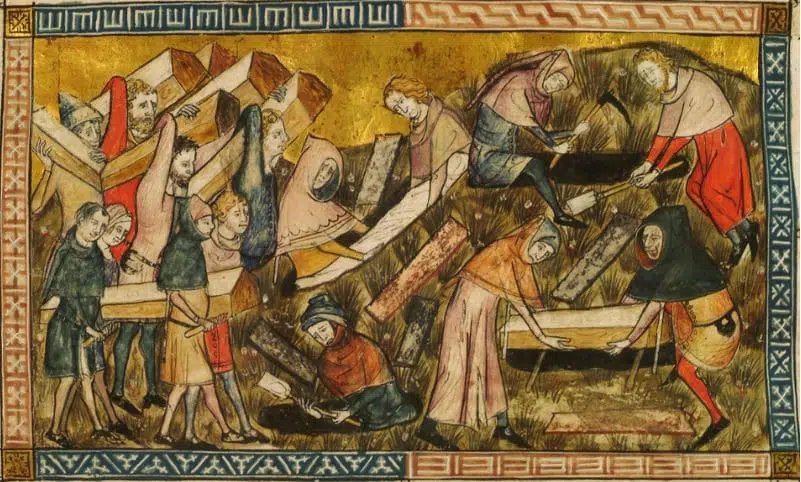David Smadja - C19 Tamar News

The American Red Cross removed a victim of the Spanish flu from a house in Missouri 1918

Healthcare workers transport a patient on a stretcher into an ambulance at Life Care Center of Kirkland in Kirkland, Washington on 29 February. Photograph: David Ryder/Getty Images
Primo Levi said "To forget your past is to be condemned to relive it".
Politicians forget, too often, this principle of life, dealing in the urgency, the tragic events tragic events that humanity is going through and being too busy to take care of their re-election.
The treatment of the pandemic of Covid 19 does not escape the rule, it would have been necessary that the governors should have looked at the past and studied the course of the previous pandemics that ravaged the world such as
the Black Death of the 14th century or more recently, the Spanish Flu of 1918.
Already in 1348, almost a third of the European population disappeared in this tragedy and the figures differ according to the historians, between 70 and 220 million people died .
Containment measures were adopted in France and in other countries and hygiene rules were adopted.
At that time, the decisions of the Kings or other leaders are slow to react and hide the reality of the situation, that will lead to the most serious sanitary that the world has known.

The Citizens of Tournai, Belgium, Burying the Dead During the Black Death of 1347-52. Detail of a miniature from The Chronicles of Gilles Li Muisis (1272-1352), abbot of the monastery of St. Martin of the Righteous.
The Spanish flu in 1918-1920 killed more than 50 million people and the evidence of this troubled period is
period are impressive, especially in Quebec.
I was faced with a terrible disease, never seen in Montreal in living memory. […] The patients became blue, they could not breathe. […] I sometimes saw 50 cases a day, and sometimes 4, 5 or 6 patients in the same family, all lying down; I came back the next day, and 2 or 3 of them were dead. This testimony of horror, collected in 1976 at the microphone of Lizette Gervais, on Radio-Canada, is that of Dr. Albert Cholette, confronted with the influenza epidemic of 1918 when he was a young doctor in Montreal.
His account is chilling: it expresses the powerlessness of science in the face of an elusive enemy that was killing adults in the prime of their lives who had been lucky enough to survive the fighting. “What was striking was the speed with which people were dying.
People were dropping like flies, especially since this epidemic came after the first world war which had killed more than 20 million people, the fate was getting harder on humanity. This disease was killing at an incredible speed.

In the world, the medical world is powerless and charlatans are legion with products with products that have no effect.
With a mortality rate 10 to 30 times higher than that of classical flu epidemics, the 1918 epidemic was by far one of the worst that humanity had ever known. In a few months, it will claim between 50 and 100 million victims – three times more than the Great War itself. One third of the world’s population was infected, with mortality rates reaching 50% in some countries! From the Pacific Islands to the Inuit villages of Northern Canada, no region of the planet will be spared.
This epidemic is particular because it is composed of 3 successive waves, after the first wave, everyone thought that the virus was eliminated while the second wave arrived in October will be the most deadly.
What is most surprising is that half of the dead are adults between 20 and 40 years old, while the classic flu decimates almost only babies and elderly people.
The epidemic in French Polynesia is terrible and the local politicians are not aware of the strength of this virus.
Thus, in a 1919 issue, L’Illustration reported in detail the drama of Tahiti where the pandemic had taken dramatic proportions. On November 16, 1918, a liner, the Navua, coming from San Francisco docked at Papeete. There were several people with influenza on board.
However, the landing was authorized. Despite the death of several sailors, the authorities minimized the affair. They even authorized the organization of celebrations in honor of France’s victory over Germany. What followed was terrible… In less than twelve hours, half of the island’s population fell ill. The hospital was overwhelmed by the influx of flu patients. The only three doctors on the island die.
The stores close. Soon, it was difficult to get food and bread. Everything is missing. The streets are empty. Only the carts that transport the corpses to the mass grave are still in circulation. Help arrived too late. More than 1,000 people died out of a population of 5,000. That is 20 times more victims than the 1906 cyclone.
In all countries, thousands of people were sick and no one knew where to bury the dead. In Quebec, an estimated 400,000 people fell ill in 1918 and 3% died. In the last week of October, in Paris, 300 people were swept away each day.

In the winter of 1919, a third wave struck. Then the virus vanished into thin air, “except in Quebec, one of the few places on the planet to suffer another, still very deadly, onslaught in the spring of 1920.”

“Nobody knows where it came from. But we have shown that most of the eight genetic segments that make it up come from avian viruses, probably North American,” says Michael Worobey, professor of ecology and evolutionary biology at the University of Arizona, and author of a genetic analysis of the virus published in 2014 in the journal PNAS.
Yes, probably, with the increase in population, socio-economic imbalances, humanity finds itself increasingly in contact with wild reserves of viruses: new flu viruses, coronaviruses like Mers-CoV. Hence the urgency to help countries in contact with these wild stocks to cope.
The autumn 2021 will be still dangerous, if history repeats itself, there will be strong probabilities that the fourth, even fifth wave falls in the world, moreover, that the summer was very chaotic.

Governments will have to be extremely firm on mask wearing, distancing and hygiene measures.
The economic crisis will be present and the effects of the containment of spring 2020 and 2021 will be felt in the fourth quarter of 2021.
In Asia, wearing a mask is part of the daily life of Taiwanese or South Koreans, the progression of the Coronavirus is stopped.
In Taiwan, or more widely in Asia, they wear the mask in times of epidemic in a preventive purpose. The mask prevents the projection of respiratory droplets responsible for the transmission of the virus. The very fact of speaking causes projections.

In 2020 it was the masks that were missing, in 2021 it was the vaccines that were missing, now it is necessary to vaccinate all the nations of the world. poor or rich and above all, to keep the masks and the social distanciations.
In Europe and in the USA, they have strongly vaccinated and have liberated public spaces in Oceania and Japan.
They have now the masks and social distanciations but have not or little vaccinated and the virus comes back in force.
In fact, it is necessary to maintain both: Vaccinate and respect the rules of hygiene and sanitary barriers.
In autumn and winter, the world will have to show humility to face this invisible enemy that kills and hurts without respecting any border.



Comment here